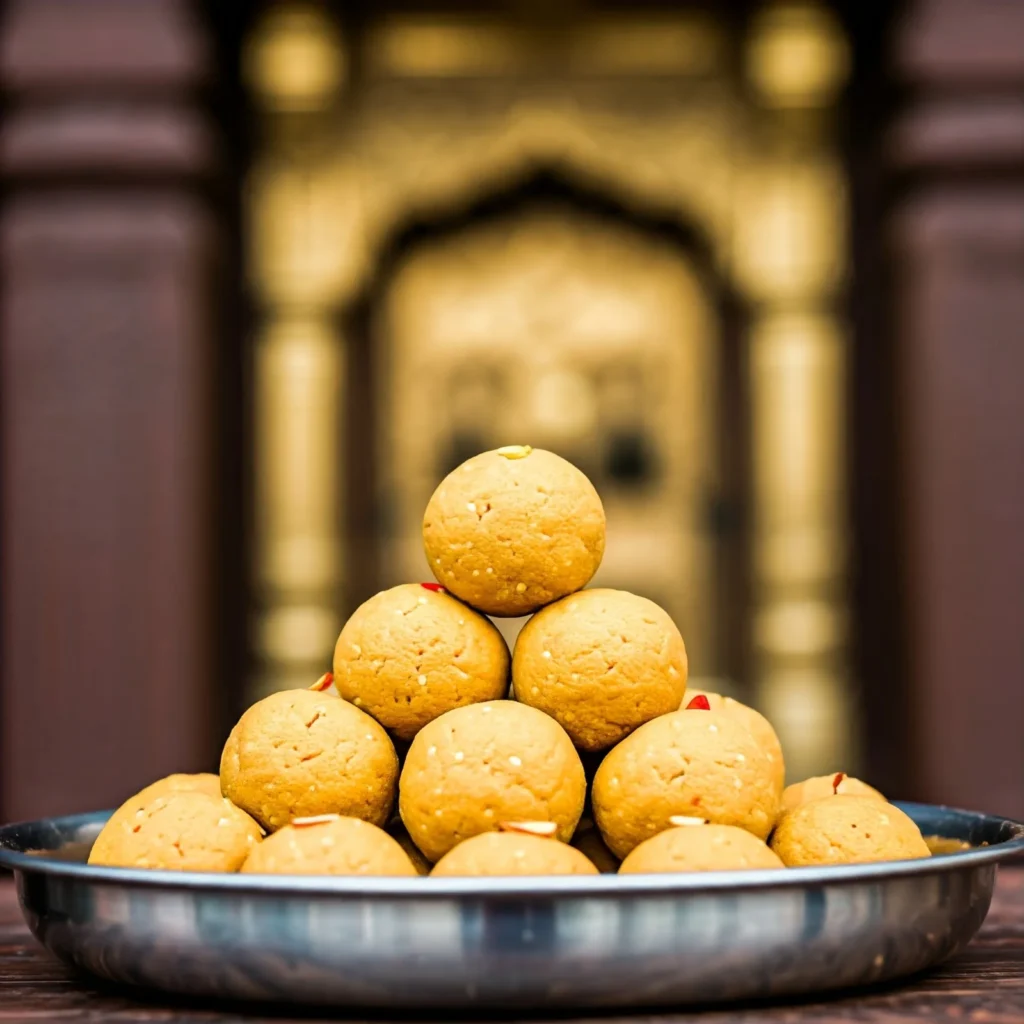Importance Of Prasadam – An Introduction

To understand the importance of prasadam, we must first understand its purpose and history.
No faith in the entire world is as diverse and fascinating as Hinduism when it comes to attaining God. We worship God in a variety of ways and a variety of forms, which is precisely why Hinduism is so widely loved. Each mode of worship is accepted wholeheartedly as a valid path to attain God. And furthermore, each mode of worship is respected by members of all sects, even if they do not follow them.
What is Prasadam? – A Definition

The food we offer to God in such a mode of worship is called prasadam. Which is why it is prepared using the best quality ingredients available in any household, and it is distributed to the devotees only after the rituals and worship are finished, meaning only after it has been offered to God and He has accepted and blessed it. Eating prasadam is considered to be holy, and one is not supposed to refuse prasad except for critical reasons.
Like every Hindu ritual, the preparation, distribution, and offering of prasadam have valid social and logical reasons. In this article, we shall subsequently explore them.
Importance of Prasadam: Why Must We Offer?

One of the most prominent ways of worship in Hinduism is visualizing God as a human. We think of God as having a human form, with human emotions and desires. We celebrate festivals to honor this human form of God, and they form an important base for worship in India.
God is the Ultimate Reality, the creator, sustainer, and destroyer of the universe. But in Hinduism, he is also treated as a human — dressed as a human, bathed as a human, fed as a human, and loved as a human.
There are many shlokas in Hindu scriptures that support the importance and explain the ideal composition of prasadam:
Whoever offers to Me with devotion a leaf, a flower, a fruit, or water, I accept it.
Bhagavad Gita (Verse 9.26)
Prasad is the immortal divine gift.
Mahanarayana Upanishad (Verse 10.1)
Consider naivedya (food offered to the deity) as prasad.
Shiv Purana (Vidyesvara Samhita, 13.11)
Prasad should be offered to please the deity, considering it as Brahman (the Absolute).
Padma Purana (Uttara Khanda, 99.15)
Ideal Importance of Prasadam?
The composition of prasadam varies from household to household, deity to deity, and even between different sects of Hinduism. Some certain foods and flowers are only offered to certain Hindu deities. Many prasad items are offered according to certain folktales or stories in the Puranas about the deities, which have a scientific background regarding the availability and nutritional value of those food items according to the region.
Examples of Prasadam
In different regions of India, various types of prasadam are served. Many prasadams are popular due to their association with renowned temples. Additionally, others are memorable because of their unique taste and rarity.
Jagannath Puri Temple, Odisha

The temple is most famous for the Mahaprasad (lovingly known as the Chappanbhog), which is a collection of 56 dishes offered to Lord Jagannath, after which it is distributed among devotees. These dishes are served throughout the span of the day.
Items included in the Mahaprasad are sweets like milk, jaggery, kheer, sweet rice, Bundi laddoos, sooji halwa (sheera), etc. There are two types of Mahaprasad, both of which can be availed in the Ananda Bazaar of the temple:
- Sankudi mahaprasad, which comprises of hydrated and cooked foods such as rice, daal, mixed vegetables, and more.
- Shukhila mahaprasad, which comprises of dehydrated and dry sweet meals.
Shri Bankey Bihari Temple, Vrindavan and Mathura

This temple is highly beloved to the devotees who visit Vrindavan in masses each other to worship Lord Krishna in the form of Bankey Bihari. The temple serves prasadam in the form of edible items that are considered Lord Krishna’s favourite – maakhan (butter), and mishri. A bhog seva is organized in the time of Janmashtami (which is a celebration of the birth of Lord Krishna). A feast of various dishes is offered to Bankey Bihari, which is prepared according to the instructions given by elder priests.
Sri Venkateshwar Temple, Tirupati

This is a very famous temple in India, popular amongst devotees of all sects alike. The prasadam at this temple has been continuously served to devotees for 300 years, dating back to 1715. The prasadam is in the form of a large laddoo made from rice, chickpea flour, cashews, sugar, and ghee.
Kamakhya Devi Temple, Guwahati

One of the most unique temples in India, it is believed that Goddess Kamakhya goes through an annual cycle of menstruation. The temple is one of the 51 Shakti Peeths of India, which are holy sites for the worship of Devi (Mother Goddess). The prasadam here is of two types:
- Angodak: Water offered to the Goddess is distributed amongst the devotees.
- Angavastra: A piece of red cloth that is used to cover the goddess during the menstruation days, and it is later distributed amongst devotees.
Mahakaleshwar Temple, Ujjain

The Mahakaleshwar Temple in Ujjain is deeply connected with the central theme of the city’s worship of Lord Shiva in the form of Lord Mahakal. The temple serves prasadam in the form of a laddoo, fire ash (bhasma) from the Bhasma Aarti, vermillion (sindoor), and a small photograph of Lord Mahakal.
Vaishno Devi Temple, Jammu and Kashmir

The temple of Vaishno Devi is also one of the 51 Shakti Peeths of India, which are holy sites for the worship of Devi (Mother Goddess). The temple offers prasadam in the form of Mishri, a sweet made of milk, and a coin which has the image of Vaishno Devi sitting inside the temple carved on it.
What are the Rules for Preparing Prasadam?

Certain rules must be adhered to when preparing prasad, because these can vary among different sects within Hinduism depending on regional practices, scriptural guidelines, and cultural history. Thus, the preparation and the method of serving are both equally important.
Some such regulations are as follows:
- Prasadam must be prepared in a clean area with clean utensils and ingredients.
- Only Sattvic food is offered to God through Prasadam.
- Prasadam must be offered to God first, and then to the devotees.
- Rajasic and Tamasic foods such as meat, onion, and garlic are not offered to God. This rule, while generally accepted, may vary across different regions of India where non-vegetarian foods are staple and acceptable religiously.
Therefore, these rules may not always apply due to sectarian differences or individual beliefs. The best example is Shabri from Ramayana, who first took a bite out of all the berries, and only fed the sweetest ones to Lord Ram.
At the end of the day, it is individual devotion and intention that matters above everything else. The goal is to enhance the progress of the individual towards God. All actions should be performed with this purpose in mind.
Importance of Prasadam: Offering and Consuming
After the worship of God is completed and the prasadam has been offered to Him, it is generally offered to the pujari or the person conducting the worship first. Then the elderly and children in the household are served the prasadam, after which others take it. A small prayer must be spoken or remembered mentally to thank God for his blessings and grace, after which the prasadam may be eaten. Thus, taking prasad in itself becomes an act of worship.
If offered directly, Prasadam is ideally taken in the right hand. It is considered taboo to throw away or reject prasad, unless in some critical circumstance.
Logical Importance of Prasadam
There is also a logical significance to the items offered as prasadam. All the items used in the offerings are sweet or are considered universally delicious. They elevate the mood and create joy in the mind of the consumer. A peaceful and pleasant mind is ideal for the devotion of God. The desirable taste of the prasadam also creates satisfaction in the devotee’s mind towards the puja and all the other worship that has been performed. Thus, they leave the place of worship in a positive mood.
Social Importance of Prasadam
The social importance of Prasadam is what truly makes it so special. It is a practice that aims to unite a community further under the image and devotion towards a common deity. Undeniably, puja and worship are an important aspect of devotion for householders. Everyone who takes the prasadam offered to a particular deity is present there with devotional and pure intentions. When the prasadam is distributed to the people who were not present at the place of worship, then it signifies that one is sending well wishes and the blessings of God to that person. This improves relationships between families and communities. No matter how poor the relations between any two people may be, no one turns away Prasadam.
The intention behind any task performed determines the quality of its outcome. This has been preached by our scriptures for a long time. The preparation of prasadam is always done by a devotional person. It gives good merit (punya) to the one who prepares it and to the one who consumes it. The prasadam offered to God or a Guru is considered very pious and holy. Thus, it is believed that eating it gives one good blessings and fortune.
It is forbidden by the scriptures to charge money for anything spiritual – be it knowledge, worship, or work. This is done to ensure that God remains accessible to everyone who desires Him. Traditionally, everything related to God and His worship is supplied by the working members of a community, including the sustenance of the pujaris. They are forbidden from taking any monetary payment for their services as a key rule. This creates a sense of equality in religious places, where everyone is equal in the eyes of God. Therefore, prasadam is distributed without any discrimination amongst all devotees.
The Importance of Prasadam: Conclusion
The importance of prasadam is significant in Hinduism. It signifies the love of a devotee towards God, who has been visualized in a form that is pleasing to the devotee. God is believed to interact with or answer the prayers of His devotees, no matter who they are in this way. It is a link between communities and a link between God and His devotees.
More from Ananya Akruwala:


